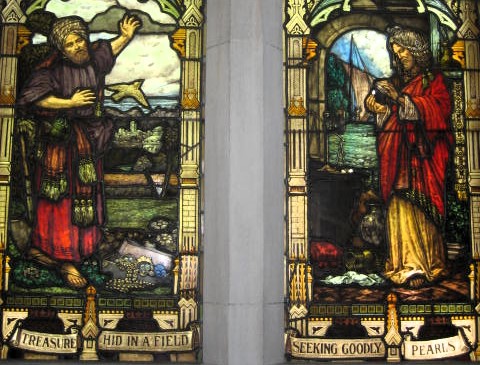Along with the Mustard Seed story in Matthew come several other one-liners that are almost as famous. The Good News in his first parables did not seem much like good news, as the gist of those was that the world was going to end and most people would not be saved. But these are found together in Matthew’s Gospel, form an important change of topic.
For these parables contain the very first exciting suggestions that the “Kingdom of Heaven” is not just the starry sky nor some incomprehensible state of being beyond the end of time. Rather the Kingdom of Heaven is also something quite real, albeit very mysterious, found right here on Earth. Yet while that was doubtless quite exhilarating, it did not sound like the restored Kingdom of David the Jews dreamed of, but what the Early Fathers would come to call “the Church”.
These other parables are named the Leaven (which also appears in Luke), the Hidden Treasure, and the Pearl. So we will go through them one by one, first by the Gospel version followed by its TSM interpretation. As before the bracketed terms are those substituted in the interpretation, and the term “like” removed.
The Parable of the Leaven
Matthew
He spoke another parable to them. “The [Kingdom of Heaven] is like [yeast] which a [woman] [took] and [hid] in [three measures] of [meal], until it was all [leavened].” (Matt. 13:33)
He spoke another parable to them. “The [presence of God] is [truth] which a [soul] [accepted] and [placed within] the [complete mass] of [religious instruction], till it was all [eloquent teachings].”
Luke
Again he said, “To what shall I compare [God’s Kingdom]? It is like [yeast], which a [woman] [took] and [hid] in [three measures of flour], until it was all [leavened].” (Luke 13:20-21)
Again he said, “To what shall I compare [God’s reign]? It is [the Church], which [a church] [believed] and [placed within] [humanity], until it was all [taught].”
The Parable of the Hidden Treasure
“Again, the Kingdom of Heaven is like [treasure] hidden in the [field], which a [man] [found] and [hid]. In his joy, he goes and [sells all that he has] and [buys] that [field].” (Matt. 13:44)
“Again, the [presence of God] is [wisdom] hidden in the [Scriptures], which a [sinner] [understood] and [took to heart]. In his joy, he goes and [converts] and [believes] that [Scripture].”
The Parable of the Pearl
“Again, the [Kingdom of Heaven] is like a [man] who is a [merchant] seeking fine [pearls], who having [found] [one pearl of great price], he went and [sold all that he had] and [bought] it.” (Matt. 13:45–46)
“Again, [sanctification by the Spirit] is a [sinner] who is a [student] seeking fine [wise sayings], who having [understood][knowledge of Christ], he went and [converted] and [believed] it.”
It is fascinating how the simple change of terms can lead to an entirely different interpretation that compliments rather than contradicts another one. The allegorical meanings that emerge are not precisely what the Gospels may have meant, but are informed by the teachings and speculations of theologians, particularly the Early Fathers of the Church.
Stripping away the accretion of centuries to a simple, direct reading is quite valuable. Hidden themes running through the parables are now visible. Already, the evolution of Jesus’ preaching is evident. He started with the end of the world, and with these, he first shows the way to survive.
Yet, the intention of this experiment is to investigate what other meanings Jesus may have concealed within his stories. Many important keys have been lost but TSM, by revealing associated meanings, may lead to their discovery. Stay tuned!

